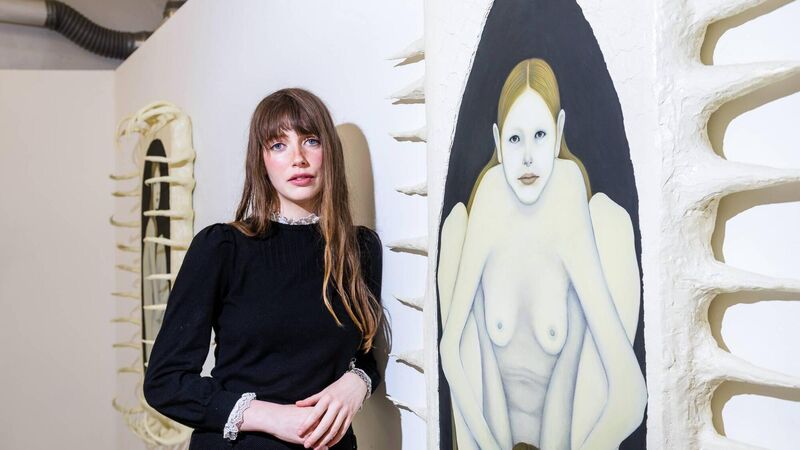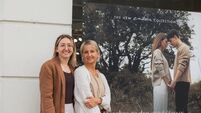Cork artist: ‘A lot of my work is very vulnerable’

Lara said she neglected her artistic side in her teenage years, but found it again in her 20s.
Emerging artist, Lara Quinn, has cleverly imagined the vault at the Lavit Gallery as a womb-like cave tied to the feminine.
And within the dark subterranean-like space, the viewer will see a video of Lara, nude, who adopts the figure of Lilith, a figure in Jewish mysticism and Eve’s predecessor.
She slowly emerges from a cave that is in Roscommon, (Cave of Cruachan), known as Oweynagat, an Anglicisation of Uaimh na gCat.
It’s the main feature of Lara’s first solo exhibition at the Lavit, which is part of her prize as the recipient of the 2024 Cork Arts Society Student of the Year Award.
This annual award is given to one or more graduates of MTU Crawford College of Art & Design and comes with a cash prize of €1,000, sponsored by Baker Tilly Accountants.
Leading artists who were awardees of the prize include John Burke, Maud Cotter, Eilis O’Connell and Vivienne Roche.
Lara, 26, from Carrigaline, admits that being filmed naked was “daunting and slightly mortifying. A lot of my work has always been very vulnerable. This is probably the most extreme.”
She points out that she always backs her conceptual art with research.
In this case, the artist attempts to subvert the story of the hero’s journey by adopting the Lilith figure as a surrogate to take on the role of her alter ego throughout. This gives Lara distance from the figure, although her art tends to be highly personal and private.
“But instead of it being a self-portrait, it’s a portrait of Lilith.”
Pointing out that nude performance art is nothing new, Lara refers to the line-up at Tate Modern next year with work to be shown by three internationally famous female artists; Tracey Emin, Frida Kahlo and Ana Mendieta.
“Ana Mendieta’s work was my introduction to nude performance. I researched her frantically.
“In Ireland, I looked at artists like Jesse Jones, Alice Maher and Áine Philips, and also the entire body of work by Aideen Barry.”
A woman’s body “can become almost political. It’s controversial to have the naked body on show because it is so sexualised in our culture.”
But as Lara says, her body in the video “is absolutely not sexually explicit. The body for me, in this way, is just like the landscape, an animal’s body within nature. That’s why it’s not uncomfortable but it’s still jarring because some people are not used to seeing a nude body outside of the sexual environment.”
There are also nude paintings of Lara on the walls of the exhibition space as well framed relics of religious ornamentation.
Lara is fascinated by religion but is not religious herself.
“When I was working with the cave, I kept thinking of Lazarus from the Bible.”
The exhibition’s title, Lady Lazarus, comes from the title of a Sylvia Plath poem.
“Funnily enough, a lot of the imagery in that poem is almost symbiotic with the imagery in my work. Sylvia Plath references a cave, cats and rebirth. It’s fascinating. Her poem is pessimistic, dealing with suicide ideation. I’m not looking at that from my perspective. I’ve used imagery to give the idea of a woman fallen and being picked back up again.”
As part of her research, Lara reached out to archaeologist and author, Dr Marian Dowd.
Marian spoke of neo-pagan activities that went on in the Roscommon cave as recently as the 1990s. Rituals were carried out there. Hair was found in the cave so hair-cutting was one of the practices. Also, coins and crystals were found there.
“Queen Maeve was supposed to have lived in the area and, apparently, Morrigan, from Irish mythology, lived in the cave. So there’s this female witch entity that has lived there. Blood was also found in the cave. There is a dark strong feminine quality associated with it.”
Lara herself cut off a lot of her long hair in the video and one of the exhibits in the Lavit’s vault is this brown hair, coiled and silky.
“In a lot of cultures, hair holds meaning and people don’t want to cut it until a certain age. For me, the meaning was my whole experience of studying art. All the memories were in the hair and I was starting a new chapter of my life as an emerging artist. Cutting my hair signified a transition.”
Lara studied art history at UCC for two years but did not finish her BA degree as she yearned to pursue painting as opposed to just learning about the academic side of art. She wanted to attend Crawford but first did a Post Leaving Cert course at the former Colaiste Stiofáin Naofa (now, the Cork College of FET).
“It was an incredible course. From there, with my credits from UCC and my PLC, I was able to get advanced entry into second year at the Crawford.”
Always drawn to the arts, Lara says that during her teenage years however, she didn’t have much confidence in her art.
“So I totally neglected that side of me. I found it again in my early 20s.”
As well as the Student of the Year Award, Lara won a number of other graduate awards including Best Thesis Prize and a Cork City Council Purchase Prize.
She is hoping to develop her practice before enrolling in an MFA programme abroad in a few years’ time. Definitely a name to look out for.
Lady Lazarus is at the Lavit Gallery until May 3.







 App?
App?


